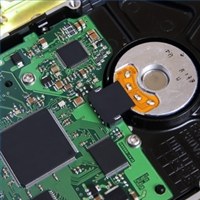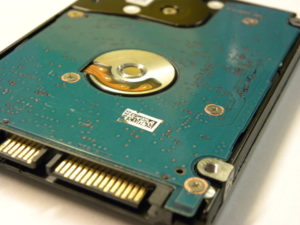
The underside of an internal hard drive.
If you’ve noticed a burning smell from your computer or external hard drive, or if the device is completely dead (unresponsive and the computer fails to recognize it), you may be looking at a damaged hard drive circuit board.
The good news is that in most cases, the data on the drive is recoverable. A burnt or damaged Printed Circuit Board (PCB) is a serious hardware failure, but it does not permanently destroy data.
With that said, the recovery process is not as simple as just swapping the bad board with a good one. It requires specialized tools and an understanding of how modern hard drives store unique firmware information.
Below, we’ll explain what a PCB does, why simple PCB swaps don’t work on modern hard drives, and how we perform the recovery. For help with a hard drive failure, call 1-800-237-4200 to speak with a specialist or submit a ticket online.
What Is a Hard Drive Circuit Board (PCB)?
The PCB is the board on the bottom of your hard drive; it’s usually green or blue. It acts as the brain for the drive hardware, translating your computer’s commands into the physical actions of the drive’s internal components. It controls the spindle motor that spins the platters (the magnetic disks that store your data) and manages the read/write head assembly.
A key component on this board is a ROM chip (or integrated data on a larger controller chip), which stores unique, drive-specific calibration data. It contains information that the HDD needs in order to operate.
Why a Simple HDD Board Swap Doesn’t Work Anymore
 If you’re trying to repair a device with a failed component, the obvious solution is to swap out the damaged part with a functional one.
If you’re trying to repair a device with a failed component, the obvious solution is to swap out the damaged part with a functional one.
On much older hard drive models, you could sometimes get away with finding an identical drive and swapping its working circuit board onto the failed drive. But modern hard drives are manufactured with incredibly tight tolerances: The unique calibration data stored on the PCB’s ROM chip, sometimes called “adaptives,” tells the drive’s heads precisely where to find the data tracks on its specific set of platters.
The bottom line: No two drives are identical. If you simply swap a donor board onto your drive, the new board’s ROM data won’t match the physical characteristics of your drive’s internal hardware. The drive will not be able to initialize, and the heads may move back and forth, but you won’t be able to read data.
And operating a drive with the wrong configuration of operating instructions could cause a head crash. That can lead to platter damage, which is permanent and irreversible.
Our Process for Damaged PCB Recovery
When we receive a drive with a damaged circuit board, our engineers follow a precise and delicate process to access the data safely.
- Evaluation: The first step is to confirm the PCB is the point of failure. Our engineers examine the board for burnt components and perform additional analysis to determine whether mechanical components have been impacted by the failure.
- Sourcing a Compatible Donor Board: Once we confirm PCB failure, we find a compatible donor board. This requires matching not just the drive model number, but also specific board numbers and firmware revisions to ensure compatibility. We maintain an extensive library of hard drives; learn about the Datarecovery.com hard drive parts inventory.
- ROM Chip Transfer: Using micro-soldering equipment, an engineer carefully desolders the original ROM chip from your damaged board and transfers it to the healthy donor board. The drive’s firmware may need to be adjusted with specialized hardware designed for that purpose.
- Imaging and Verification: We immediately create a full, sector-by-sector clone of the drive onto one of our stable systems. All subsequent recovery work is performed on this clone, ensuring that the process is non-destructive (the original drive and its data are not at risk).
If a drive’s electronics board is the only damaged component, cleanroom data recovery isn’t strictly necessary. However, it’s important to note that electronics failures often coincide with head crashes, so we may open the drive to inspect its physical components prior to performing board swaps or other operations.
Datarecovery.com does not charge cleanroom fees, and our services will not void hardware warranties. All services are supported with a comprehensive no data, no charge guarantee.
Professional Data Recovery for Hard Drive Electronics Issues
If you suspect your drive’s circuit board has failed, take immediate steps:
- Leave the drive powered off. A short circuit on the PCB can send improper voltage to sensitive internal components, which can lead to head failure. Powering it on repeatedly can complicate data recovery efforts.
- Don’t attempt a board swap. Attempting to swap the board or the ROM chip yourself is extremely risky. The ROM chip is delicate and can be easily destroyed by heat or improper handling, and a damaged ROM chip can make recovery impossible.
- Disconnect the device. Unplug the device from its power source and contact a professional data recovery provider. Note: If you’re uncomfortable removing the drive from your computer, simply leave it powered off — your data recovery provider can safely remove the drive for you.
A burnt PCB is a common and highly recoverable issue. The prognosis for data recovery is good, provided that you keep the drive powered down at the first sign of damage.
At Datarecovery.com, we provide a risk-free evaluation, and our no data, no charge policy guarantees that you only pay for a successful recovery. If you have a drive with a damaged circuit board, we’re here to help. Contact our experts at 1-800-237-4200 for a free consultation or submit a case online.




